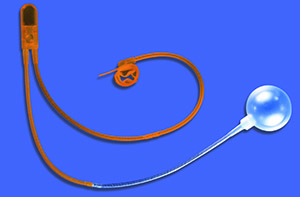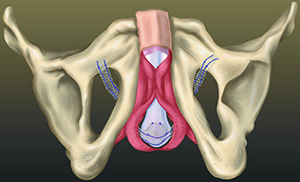Male Urinary Incontinence
Click Here to Watch Dr. Engel’s Presentation on Male Urinary Incontinence
Male urinary incontinence is a much less common problem than female incontinence, and the causes tend to be quite different. Let’s talk about the different causes for urinary incontinence. In women, there are generally two types – stress and urge incontinence. Stress incontinence is most commonly a result of vaginal laxity, a structural problem where the bladder gets less and less supported by the anterior wall of the vagina. This can be caused by previous childbirth, menopause or simply aging. With this in mind, the strategies behind addressing this type of incontinence center around adding more support to the pelvic floor or vaginal wall. This is accomplished either by exercises, often called Kegel exercises, or by procedures designed to provide a backboard for the bladder to push against during times of increased abdominal pressure – an act previously performed by the vagina.
Another type of incontinence typically seen in women, but at times in men also, is called urge incontinence. Urge incontinence is really just an end stage of the progression of overactive bladder. Here, the bladder is irritable perhaps due to vaginal wall atrophy, menopause in general, stress/anxiety, prostate obstruction in men, or for reasons unknown. What is happening is the bladder is deciding to squeeze on its own, and if the contraction is forceful enough, the patient simply cannot stop it and leaks on the way to the bathroom. Urge incontinence is primarily a medical problem, although we now also have botox injections or even implanted nerve stimulators than can be used as procedural alternatives best applied if oral medicines fail.
Male urinary incontinence typically has a very different cause than incontinence seen in women. Men will most commonly suffer from two other types of incontinence – overflow, and post-prostatectomy incontinence. Overflow incontinence occurs when the bladder is in retention, or full even after a man urinates. This is usually due to an obstruction caused by an enlarged prostate (BPH) that has occurred slowly over time. An urethral stricture can also cause this. For a discussion on the management of end stage BPH, please refer to that section of this website.
Post-prostatectomy incontinence is unfortunately a common problem in our society, and a severely under-addressed and under-treated problem. This type of incontinence can occur rarely after some BPH procedures (approximately 1%), but the far more common reason to see post-prostatectomy incontinence is after a radical prostatectomy for cancer, regardless of the type of surgery performed. Post-prostatectomy incontinence is not a structural problem. We all stay dry because the bottom of our bladders, or the bladder neck, puckers and contracts on its own. This is just like the anus, and just as we can voluntarily squeeze our anal sphincter for added closure further downstream, we can do the same with our voluntary urinary sphincter. After prostatectomy, the bladder neck will sense trauma, and will not fully close. Permanent incontinence will result if the bladder neck never fully closes, and the amount of pad usage will be related to how open the bladder neck remains. Exercising the voluntary sphincter (Kegel exercises) will not affect the bladder neck and is therefore not a solution for permanent post-prostatectomy incontinence.
Now, in the era of robotic prostatectomy, total incontinence is fortunately very rare, but mild incontinence is not.
The era of open radical prostatectomy, particularly when that operation was more aggressive than it ultimately became, produced many men with more severe incontinence called total urinary incontinence. Now, in the era of robotic prostatectomy, total incontinence is fortunately very rare, but mild incontinence is not. Dr. Engel quotes at least a five percent chance of some pad usage after robotic prostatectomy at one year. When one considers how many men have undergone prostatectomy over the last 25 years, most being performed in an era when permanent incontinence rates were far higher than they are today, one can easily realize how many men are living with this problem in our society. One walk down the incontinence aisle at your neighborhood supermarket will show you that the problem is very common indeed.
The main impediment standing in the way of treating men with post-prostatectomy incontinence is getting men to know that a relatively easy solution exists and that permanent post-prostatectomy incontinence is not at all something one needs to live with or simply “get used to”.
The main impediment standing in the way of treating men with post-prostatectomy incontinence is getting men to know that a relatively easy solution exists and that permanent post-prostatectomy incontinence is not at all something one needs to live with or simply “get used to”. Another large problem with getting these men treated has to do with the pattern by which men have historically gotten their prostate removed. As large academic centers published papers suggesting that experience affects outcome, many/most men in the past and present have had their surgery at such centers hoping to avoid a negative outcome such as permanent incontinence. Such men assumed that by making such a trip, their outcome would be better than staying at home to have their surgery. The price they often paid however is that such men may not get their post-operative care at that academic center which in some cases may be far away and not practical to return to for routine visits. Often less attention was paid to focusing on incontinence since that center was not likely to be managing it. Since the patient likely left his local Urologist to get his surgery, often times such patients went back to their internist for PSA checks. These men can be left without guidance as to how easy it is to address post-prostatectomy incontinence, and just how expected impotence and incontinence are after prostatectomy. Such men simply live with pads, making them a part of their lives. By the time they may find out that a simple procedure exists to eliminate the incontinence, a man usually has gotten used to using pads as a routine and often is not willing to take the mental step to undergo another surgical procedure. Dr. Engel sees such patients that have been operated on elsewhere and estimates that the average time from surgery to having an incontinence procedure is over four years. Dr. Engel manages his own prostatectomy patients far differently.
Dr. Engel has always made as a condition of performing a robotic prostatectomy that a patient follows up with him until his impotence and incontinence has been managed to the patient’s satisfaction.
Dr. Engel has always made as a condition of performing a robotic prostatectomy that a patient follows up with him until his impotence and incontinence has been managed to the patient’s satisfaction. Dr. Engel makes these problems, and their normal time course to recovery or resolution very clear. If a patient is still leaking at nine months, Dr. Engel’s patients will be told that it will not likely improve, and they should at that point make the active choice as to whether they want it addressed or whether they want to live with it permanently. It is always the patients’ choice, but Dr. Engel sees no reason to simply get used to this and live with this problem.
Artificial Urinary Sphincter (AUS)
 If a patient does decide that he wants to address his post-prostatectomy incontinence at that point, how much he leaks will be the key to what procedure is recommended. The procedure that can be considered the gold standard to some is called the artificial urinary sphincter (AUS). Here, something akin to a water filled blood pressure cuff is wrapped around the urethra, and a small pump is implanted in the scrotum that the patient will squeeze when he wants to urinate. Squeezing the pump will push water out of the cuff, thus deflating it, and move it to a water balloon implanted behind the pubic bone. The cuff re-inflates automatically after 60 seconds or so. It becomes very routine to use this system, and it is very effective in curing post-prostatectomy incontinence. It is the procedure of choice for those patients that leak over two pads per day. This is an outpatient procedure that carries the risk of infection or urethral erosion. Rarely mechanical malfunction occurs as well that must be repaired surgically.
If a patient does decide that he wants to address his post-prostatectomy incontinence at that point, how much he leaks will be the key to what procedure is recommended. The procedure that can be considered the gold standard to some is called the artificial urinary sphincter (AUS). Here, something akin to a water filled blood pressure cuff is wrapped around the urethra, and a small pump is implanted in the scrotum that the patient will squeeze when he wants to urinate. Squeezing the pump will push water out of the cuff, thus deflating it, and move it to a water balloon implanted behind the pubic bone. The cuff re-inflates automatically after 60 seconds or so. It becomes very routine to use this system, and it is very effective in curing post-prostatectomy incontinence. It is the procedure of choice for those patients that leak over two pads per day. This is an outpatient procedure that carries the risk of infection or urethral erosion. Rarely mechanical malfunction occurs as well that must be repaired surgically.
AdVance Male Sling Procedure
 For a more typical incontinent patient that one year post-robotic prostatectomy has 1-2 pad per day incontinence, Dr. Engel feels the procedure of choice is a sling procedure called the Advance Male Sling. This is a simpler procedure, done in one hour in an outpatient surgery center. By the next day, the patient is usually dry with no more need for pads. Here, the patient has no pump to squeeze. What is being done is the addition of just a bit more “pucker” to the bladder. The risks are fewer here, including rare leg pain and perhaps urethral erosion, although the risk is reported as less than one percent. Patients will usually be fully recovered in 7-10 days in terms of soreness and are typically back to work far before that. However, the main limitation to having a sling procedure is that the patient must avoid heavy lifting or very strenuous exercise for six weeks while the sling heals in place.
For a more typical incontinent patient that one year post-robotic prostatectomy has 1-2 pad per day incontinence, Dr. Engel feels the procedure of choice is a sling procedure called the Advance Male Sling. This is a simpler procedure, done in one hour in an outpatient surgery center. By the next day, the patient is usually dry with no more need for pads. Here, the patient has no pump to squeeze. What is being done is the addition of just a bit more “pucker” to the bladder. The risks are fewer here, including rare leg pain and perhaps urethral erosion, although the risk is reported as less than one percent. Patients will usually be fully recovered in 7-10 days in terms of soreness and are typically back to work far before that. However, the main limitation to having a sling procedure is that the patient must avoid heavy lifting or very strenuous exercise for six weeks while the sling heals in place.
If you suffer from post-prostatectomy incontinence, Dr. Engel would be happy to discuss either of these surgical options, both of which will produce at least 95% success rates in properly selected patients, during an office consultation.





